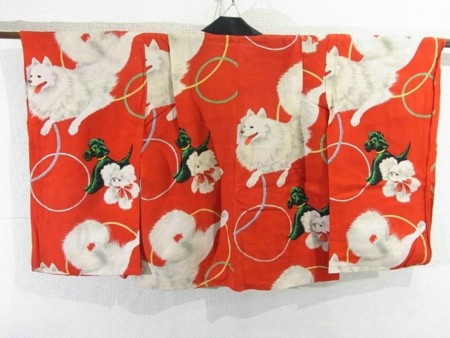Kimono Flea Market ICHIROYA's News Letter No588

Some time ago, a newpaperwoman from one of the biggest newspaper company (Asahi shinbun) came to our office. She is in charge of special article on Saturday and she wanted to ask about our business. What kind of kimono are sold well, where are our customers from...her interview continued for a long time.
She finished the article and sent us the issue. The article was titled `Do kimono have future?'
http://globe.asahi.com/feature/2015022600008.html
The photo on top shows a backstyle of a woman wearing a black kimono with dog motif at the bottom. Did you recognize the pattern?
This dog design was originally from a vintage half juban(please see the photo on top) we have. We are doing some Joint Project with Iuchi Shoten, this kimono also is one of the example of ink jet print using vintage design. The obi worn over the black kimono also has this dog motif!
In the article, she is writing about these four points:
*Shrinking kimono industry
*Recognizing kimono
*Present situation of national costume
*Garment and tradition
Regarding the first point, they write about statistics of kimono industry.
The number of kimono sale continues to decrease-it is approx 10 percent of the sale at the peak.
For example, the sale of bolts (research by Kyoto Yuzen association) decreased to 2.6 % of the sale of the peak period. According to the researchers, kimono became very special item, mostly worn for formal ccasion after WWII because of the change of lifestyle and the steep rise of labor costs. That was the plot---making up for the decrease of sale by selling items with higher unit price. Along with the develpment of media (mostly TV), they advertize fancy kimono for Coming of Age day, Weddings and so on. It seemed to have worked at the time of growing economy- however with the collapse of the bubble economy and declining of birth rate, the market started to shrink. The strategy went against them-they made kimono something so fancy and not everyday item, that made people stay away from kimono.
The industry is getting weaker at production area. For example, at Nishijin, famous area of sublime obi weaving, there were 23000 people (weavers) but after 11 years, there are only 3100. Kimono and obi making are subdivided into many procedure. One craftman is in charge of only one procedure( the work is finely specialized), so if a man closes the business, it cause the chain, and aging of craftsmen is making the situation serious.
However, the article also introduces the bright part - there are famous designers from Denmark who work with a weaving company in Kyoto to produce textile with the design not too Japanese but more modern and appealing for western people. The textiles are for interior of fancy hotels and also for famous brand from overseas. The company from Kyoto has the technique of weaving silk and foill thread together-they can make it thin and so light. Their project is going forward and they developed loom which can make `wider' textile- the textile for obi are narrow but for the new project, they are weaving wider textile.
As the example of bright future, the article includes our project of reprinting vintage design using ink jet.
The also includes this article, showing vintage farmer's workwear(boro) we sold:
http://globe.asahi.com/feature/side/2015022600002.html
The customer from abroad bought this item. The article introduces about our website and how customers from abroad find value and charms of old and vintage kimono.
The article includes the report from kimono dealers auction(the one we attend!) and 'ner generation' kimono wearers and other interesting topics also.
We are so glad they picked up this topic!